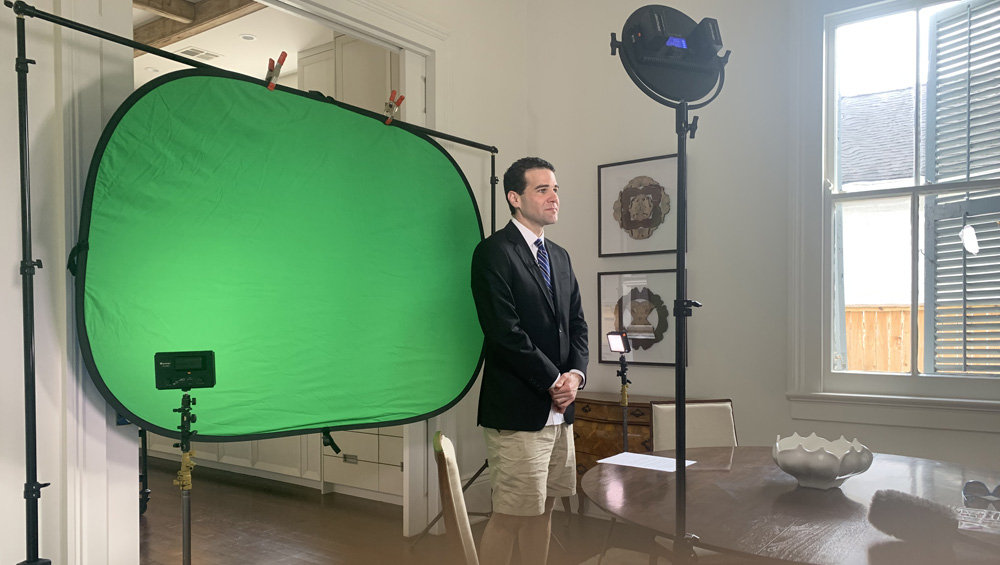
Coronavirus Raises Old And New Lessons For Katrina Vets At WVUE

Lee Zurik has a rare vantage point on reporting calamity.
He was there nearly 15 years ago in New Orleans during Hurricane Katrina when first the levees were breached and then all hell broke loose.
Now an anchor and lead investigative reporter at Gray Television’s Fox affiliate WVUE, Zurik, perhaps the city’s best-known and most widely loved television journalist, was at the point of the spear as the city became an early epicenter of the coronavirus in the U.S.
He was one of the first reporters to self-quarantine after an early potential exposure (he tested negative) and has done some of the city’s most important reporting since, including compiling emerging data into a 50-state COVID-19 tracker map that has now been adopted groupwide across Gray stations.
Zurik says his Katrina experience equipped him in some ways for what he faces now.
“From a reporting standpoint, certainly it prepares you because when Katrina hit, it just put you out of your workflow,” he says. “This is obviously very similar. We are adjusting. Nothing is normal anymore and it is over an extended period of time.”
Post-Katrina New Orleans and COVID-19 share that same extended uncertainty, Zurik says.
But in as many ways, the two experiences stand in stark contrast. Katrina hit just as the internet was taking off and before social media had become a ubiquitous part of our lives. Access to sources was difficult, but then it was because hundreds of thousands of people had been displaced. Local viewers were scarce, literally, and what few remained in the early weeks and months after the storm often didn’t have the electricity they needed to watch TV.
“Whereas now you almost have a captive audience just because most people are not leaving their homes and are glued to the news all day,” Zurik says.
A journalistic upshot of the current crisis is the technology now available and the speed it enables, he says. “Basically all of my interviews right now are via FaceTime, Skype or Zoom, whereas before if I wanted to turn stories, I would have to drive somewhere or make them come here, maybe line up a satellite.”
Now Zurik can call a source, line up an interview within minutes “and 15 minutes later it’s done and an hour later it’s on the air in a story in a nice package.”
Faster reporting speed notwithstanding, little is easy about living and working in the Big Easy once again. The city has one of the highest per capita death rates in the country from the virus. As of Thursday, there were over 8,000 cases and almost 300 deaths in the metro area alone.
As with most other TV stations, about 70% of WVUE’s workforce has been sent home to work remotely. Only in South Louisiana, staying home is an especially afflictive kind of punishment, particularly during spring’s normally crowded calendar of festivals and crawfish boils before summer’s long torpor sets in.

Ronna Corrente
WVUE GM and VP Ronna Corrente, who arrived in the city only two months ago, had a taste of that before the pandemic arrived. “People want to come together. That is the culture here,” she says. “They welcomed me with open arms, whether it was a crawfish boil or a parade.”
Helping to break the city’s intensely social habits, many of which were solidified in defiance of Katrina’s shattering legacy, became a newsroom prerogative. “We want to make sure we are getting the information out to viewers so that they do take it seriously,” Corrente says.
A lot of the work in doing that lies in data, Zurik says. “The truly impacting information in a lot of ways is numbers,” he says. “It’s how many positive cases, how many hospitalizations, what is the per capita number on that. Sometimes in television it can be hard to explain numbers and have viewers understand that. For us, visually, we have to think about creating graphics.”
WVUE’s staffers certainly have a handle on the pandemic’s severity in the city. With Zurik and several other employees having feared exposure and self-quarantining, the station got an early start on shifting its workers to remote environments. Only the news director, anchors and a handful of producers and people in master control, along with Corrente herself, have stayed behind.
That said, Corrente has left aside one room for journalists who need to come in from the field briefly, if only to use the bathroom. “There are very few places for our reporters to go to the restroom,” she says. “We make sure that room is always sanitized and cleaned on an hourly basis if reporters and photographers need to come in.”
Zurik, who is still anchoring from the studio, says the environment is as safe as anyone could hope for. “I am not within six feet of anyone at any point of the day,” he says. “Everybody kind of locks themselves in their hole.”
Gray has also armed the station with a battery of wipes, masks and other cleaning aids, and Corrente has sometimes even brought such supplies to staffers’ homes when necessary.
As with many other GMs, she has also tried to give what comfort she can to a station full of people roiled by uncertainty. It’s a different kind of uncertainty than many faced 15 years ago, when the looming questions involved what to do about destroyed homes, shuttered schools and businesses and an existential doubt hanging over the city’s future.
This time, it’s about “the uncertainty of how long this is going on,” Corrente says. “This virus is silent and you can’t see it, you can’t hear it and you don’t know when you are walking by somebody who is affected. That is scary, and they are not used to living like this. Nobody is.”
Including, of course, WVUE’s advertisers. “We have taken a pretty significant hit because New Orleans is full of events and restaurants and the events are canceled and the restaurants closed,” she says. “We want to help them through it, and we are just keeping in contact to let them know we are here as a partner, trying to figure out what the message will be when they return.”
Until they can, and until New Orleans can once again open the doors of its jazz clubs and kitchens, WVUE is offering the city a small piece of the culture it craves.
On weekends in April, the station is running a series of “Louisiana Rising” concerts featuring artists from across the state like Irma Thomas (doing a tribute to recently-deceased jazz legend Ellis Marsalis), Kix Brooks (from Brooks & Dunn) and Dave Jordan.
“It’s very raw footage,” Corrente says. “They shot it from their own homes. It’s folks sitting out on their porch [shot] with whatever video they have.”
She says the “virtual concerts” are a badly needed reprieve for viewers who are no stranger to calamity.
“People need a break,” Corrente says. “As much as we give them information as a news organization, we also recognize they need a mental break to remember that life will get back to normal and we will overcome this.”
Corrente is banking on it, and on the city’s return from the brink once again: She closed on a house there last week.
To read more TVNewsCheck coverage of how TV stations, station groups, news organizations and individuals are pivoting to work amid the coronavirus pandemic, click here.


































Comments (0)